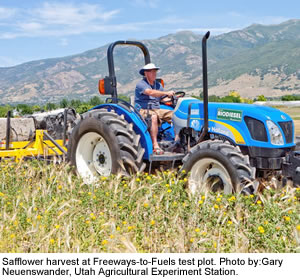 A couple of years ago, I told you about how the Utah Department of Transportation was planting safflower, camelina, canola and perennial flax in a safety strip along Interstate 15 and then crushing the seeds to make biodiesel (see my post from May 9, 2007).
A couple of years ago, I told you about how the Utah Department of Transportation was planting safflower, camelina, canola and perennial flax in a safety strip along Interstate 15 and then crushing the seeds to make biodiesel (see my post from May 9, 2007).
The “Freeways-to-Fuel” project, sponsored by the Utah Department of Transportation, the National Biodiesel Board and others, has expanded to a roadside simulation lab at the Utah Botanical Center and beyond… as chronicled in this NBB release:
“This project signals a breakthrough in how America may capitalize on millions of acres of idle lands along roadsides as well as at military bases, airports and local municipalities,” said NBB CEO Joe Jobe.
Safflower, canola and soybeans are examples of the oilseed crops that can be grown and harvested to simultaneously produce vegetable oil for biodiesel, as well protein for humans and livestock. The Freeways-to-Fuel initiative also offers a way for governments to save money. It reduces costs for mowing and otherwise maintaining the lands.
Dallas Hanks, a research scientist with Utah State University, has calculated arid regions, like Utah, spend approximately $300 per mile to maintain roadside lands. Areas with more rainfall would spend more.
“Biodiesel is the most diverse fuel on the planet, and we are pleased to have supported the Freeways-to-Fuel program, which can expand that reach even more,” said Jobe. “This initiative can also complement urban farming projects offering fruits and vegetables alongside oilseed crops.”
The project is expanding to 200 acres of Salt Lake City and County land near the airport that will become a future wastewater treatment plant. Right now, it’s just a vacant lot that even caught fire last month. Officials now think it will prove to be good ground to grow a fuel that will burn in our gas tanks.
The Freeways-to-Fuel project in Utah also has academic partners across the nation as well as corporate supporters like New Holland Agriculture.

